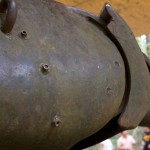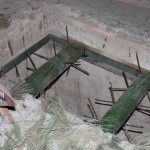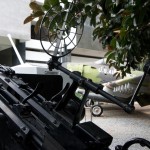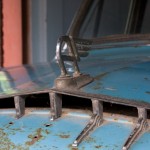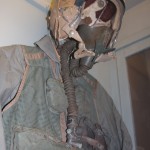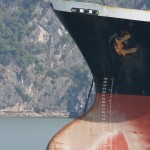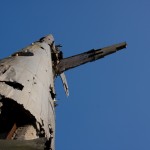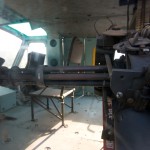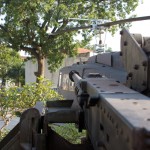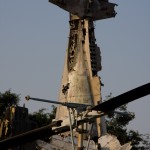We got back from our unexpectedly extended holiday in Vietnam on Tuesday afternoon. Because of the closure of Bangkok airport, the earliest flight that the local representatives of our travel company could get us out on, via KL, was two days later than planned. I’m still a bit miffed about that one, so I won’t dwell on it. Suffice to say that we should possibly have been a little more forceful about the request for an alternative flight in the middle of last week, and ignored the holding pattern response that we got.
First to trace an outline of our travels. We split the holiday into 3 main centres: we flew in to Saigon [BTW: there is no political sensitivity around the name. No-one we met called it Ho Chi Minh City]. We had a couple of days there and around Can Tho, which is on the Mekong Delta. Then we flew up to Da Nang, and drove past the remnants of the US airbase which was the main jumping off point for the war, en route to Hoi An. We had a few days there, and then drove over the Hai Van Pass to Hue. The final leg of the journey was when we flew from Hue to Hanoi, with a detour over to Ha Long Bay.
Weather wise, the south was hot – mid 30s – and very humid, but generally quite dry. One early threat to the itinerary was a typhoon which was due to hit the coast when we were supposed to be setting off for the Mekong Delta. Assuming the worst, our travel company made alternative plans for us, arranging another night in the capital. We waited it out and were lucky: the storm didn’t hit.
That exhausted our luck with the weather for the stint in the middle of the country. Hue was a bit of a washout, although we did manage to see everything that we’d planned to in reasonable comfort. The cloud cover was very low going over the Hai Van Pass, and Hoi An was partially flooded. It was quite funny: we were staying in a beach front villa there in quite a posh hotel and didn’t sit on the beach once. It was nice admiring the gail from behind closed doors though. It had been a lot worse the preceding week, apparently.
Hanoi, by contrast was really comfortable: it was dry, mid- to high 20s and low humidity.
Of the hotels that we stayed in, by quite a way, the biggest success was La Residence in Hue. With its art deco styling, friendly staff [not something that we experienced universally], and fantastic food, it really hit the mark.
Probably the most disappointing – for me, as I particularly wanted to stay there – was the Metropole in Hanoi. The staff on reception were disproportionately snooty for the quality of the rooms. The poolside bar and staff were fantastic, got to be said. I lowered the tone somewhat by actually using the pool.
The traffic is a sight to behold. If Moscow traffic is mad and fast, Vietnam traffic is just chaos. We’d ready plenty of articles about the art of crossing the road, and the fact that whatever you do, you don’t stop. There’s a little more to it than that. The thing to do is look at the next moped driver that is heading straight for you and figure out which side he/she is going to go: if they are going to cut in front of you you slow down, and speed up if they are going behind. There are a couple of complicating factors, the first of which is cars, which don’t stop for anything. The other is people going against the flow of traffic next to the kerb; that took us by surprise a few times. On our night in Can Tho, and effectively our first night in the country, we sat on a balcony enjoying snake curry and watching drivers going the wrong way around a roundabout.
Last point before getting on to the photography. We had read while researching for the holiday [in the rough guide I think] that the Vietnamese could be quite reserved. I’m not sure if we actually experienced that. What was a bit of a surprise was the number of times that people in restaurants, shops etc, had a good old giggle at us. We are both experienced travellers and have been to half a dozen countries in South East Asia between us, so I insist this isn’t me being a nutter. It was quite hard to get a handle on, to be frank: on our first night in Hanoi we nearly walked out of a restaurant. But it only happened about 3 or 4 times, and the vast majority of people that we met were friendly. Stand out of our guides was a guy called Binh who showed us the sites in Hue and Hoi Anh. I’ll try to be reserved myself with regard to two of the other guides who, independently, told me that I looked like Mr Bean. Hmm… Ok, I’m European, have a side parting but…
The new camera performed very well indeed. I was glad of the fact that it has a more robust build quality than the 400d as it got a couple of knocks, part and parcel of crawling through tunnels, getting off and on boats, and just the general handling over the duration of the two weeks. The waterproof cover of my camera bag got a pretty thorough workout too. All in all, I was pretty pleased with the way the kit performed.
I exposed something like 1200 shots over the course of the holiday. I took two 4 gig cards with me and, in the days leading up to the departure, started to wonder if I’d have enough storage. Having left it too late to order online I decided I’d check out the prices in Duty Free at Heathrow where, for the exact same card that I have [SanDisk Extreme III] it was £56. Pretty startling, given that I’d paid 16 quid for one on Amazon about a month ago. Nothing like trying to make the most of your captive audience; I skipped as I wasn’t quite that desperate. I deleted on camera as I shot, and retained about 280 – 290 shots per card. Of that total, I figure there are about 5% which are either out of focus completely, focussed on the wrong thing, or just unexplained failures. Of the remainder, I’ll probably keep about 60% and am particularly pleased with about 3 or 4 shots. Apart from a few long exposures and flash shots, I kept the camera on aperture priority the entire time.
In general, I thought I’d be falling over myself in terms of subject matter and I wasn’t disappointed. Ha Long Bay in particular was like shooting fish in a barrel. On with the selection…
First interesting port of call in Saigon was the Cu Chi. I’d read an interesting book on the tunnel systems and their role in the war, but it was fascinating to see it first hand:
The guide asked me if I wanted to have a go at getting into this entry hole, which is original size [as opposed to the tunnel system which is open to visitors, and which has been widened significantly]. I declined, in order to try to preserve some dignity.
This is a close up of a wrecked American tank, which was destroyed by a mine in 1970:
The point of this shot was the bullet impacts, heavy calibre by the looks of it, which are clearly visible on armour. Although the depth of field is too shallow here, it’s still a pleasing result in terms of the absence of noise. This would have been at the performance limit of my old camera.
One final shot from Cu Chi [I’ll spare you the picture of me in my shorts in the tunnel], one of a number of what I suppose would be described as an anti-personnel devices which are on display:
Not photographically significant [shot on the flash] but it does reinforce the brutality that both sides inflicted on one another during the war. Speaking of which, our next port of call was the War Remnants Museum. There is a lot of very interesting American hardware parked up outside. There is also a selection of some of the most harrowing images and displays I’ve ever seen.
I like the image of the Huey. There is some chromatic aberration on the tip of the rotor blade; with the benefit of hindsight, I’d go a bit longer on the depth of field at about ISO 500. This was the first of a few workouts for my ultra wide. Just a quick tangent on lens usage: the one that stayed in my bag most was my 50mm prime. Unusual, as in past holidays it has been a constant fixture, especially for low light shots. I’d figure that the higher ISO performance on the 40D explains this to a large extent. Another interesting comparison with the 400D is with the two night shot attempts I had in Hanoi, the results of both of which sucked, to be quite frank. This, I think, is the only time that I really bumped up against an operational difference between the old and new cameras. The problem that I was with massive blowouts on what I’d figured were well within the contrast range of a long exposure [30 seconds]. It might be interesting to go side by side with the 400d next time we’re in Ireland [where it now resides in the clutches of the eldest brother]. Is my geek showing?
Next destination for us was the Mekong delta. Here is a selection of images that give some flavour of life on and around the river:
The 3rd picture is included principally because our guide told us that the cargo was a coffin. It was absolutely pouring, and I was at the long end of my 100-400mm zoom. The focus isn’t great but I quite like the shot.
Some more pictures from our second and final day on the delta, which started with a breakfast cruise at sunrise, and then a visit to the floating market. The bridge at sunrise is completely out of the camera, with no post processing. The construction is part of a massive development programme in Saigon, and will provide a new route into the city. Our guide was telling us that a section of the bridge collapsed a couple of months before, killing 50 workers.]
The boat below sells mobile phone SIMs:
You have to love our boat owner’s relaxed driving style:
The next shot has slighty boxy cropping to remove part of our own boat from the shot. I hadn’t realised that the market we were visiting was wholesale.
And one final shot from the road on the way back to Saigon:
One of the many extraordinary loads that we saw people carrying on their mopeds. Unfortunately I didn’t get a shot of the load from about 15 minutes earlier when we saw someone carrying 4 fully grown sheep. How? Easy: one in the footwell, one on either side like big woolly paniers, and the last one lashed to the pillion seat. I have another shot, actually one that Sarah took, of a guy with a pretty large calf on the back of his bike.
I’m skipping over a few days of our holiday at this point: I have quite a few shots of Hoi Anh, but nothing terribly interesting. Our next pitstop was Marble Mountain. This was the first time that I got the tripod out on the holiday. This was an absolutely fascinating spot, I could have spent the entire day wandering around it. But we were time constrained and didn’t want to be anti-social with my wife. This cave is historically significant:
A VC anti-aircraft unit was holed up in it [around 1970 I think], and the source of light comes from the aftermath of a bombing run by American planes. The slightly smoky effect comes from incense. I quite like the composition in this next shot, although the light balance runs over- to under-exposed from left to right:
I’ll include one failure for purposes of completeness. I’m actually gutted that this came out really blurred:
The subject was fantastic as the marble carving was covered in water that was dripping down from the ceiling of the cave. I don’t know what went wrong, but I’m speculating that the ballhead slipped during the course of the exposure. The next shot of the same statue [slightly worse composition, looking up from a closer camera position] is pretty much the same.
The next stop on the trip was the Hai Van pass. It was a really exciting, occasionally scary drive. It was a shame that the cloud was so low. We loved this sign:
The rest of the shots of the valley were a right-off in terms of interest. The next couple of days were spent in and around Hue.
Next up was a trip on the perfume river. I quite like this shot:
The bamboo across the top left of the shot detracts from the composition. My clone stamping skills aren’t up to the change in background, with the transition across the waterline, and then were it disappears into the sand.
The next venue was a monastry in Hue which I forget the name of. One unexpected item on display was this car:
It’s a close up of the hood ornament from the car in the famous shot of the monk [called Thich Quang Duc] who self immolated in Saigon in protest at policies against monks in 1963. I’ll avoid the politically insensitive humour around the fact that it’s a product of British engineering, reliability etc. Next up is a selection of shots from Ming Manh’s tomb:
… and en route to the Citadel, some cattle relaxing in a way that I figure you only really see in Buddhist countries:
We move on to the last leg of the trip, and Hanoi, starting with a few shots from the Hanoi Hilton. The flight suit is what John McCain was wearing when his plane was shot down. The guillotine included some grizzily before and after shots.
And so we get to the shot for Guy [with whom I lost in comprehensive manner an argument about my choice of camera purchase: he looked at, and dimissed, the 40D in favour of the D90 when he was deciding to buy. I’d make the same choices if I were to replay my buying decisions, but the Nikon is certainly the better camera pound for pound. We just need to try to rationalise his choice of footbal team…], as I limp along with my mere 9 autofocus points :). This motion blur shot, combined with the focus set to the rightmost point, has come out pretty well from a technical point of view. The cyclo driver that Sarah had was a real live wire.
I love this shot:
I could add about 30 shots of Ha Long Bay, which was our final stop on the journey. We had an overnight stay on a 12 berth junk called the Ha Long Bay Jasmine.
This next shot includes an interesting and simple technique that I found online to remove the blue haze that you tend to get with landscapes. You add a levels adjustment layer, and then in each of the colour channels, shift the left slider up to the start of the curve.
I could go on: I have, literally, a hundred or so images like this. I’ll skip ahead to the end. We went to a water puppet show on the way home from Ha Long Bay, which was really good fun. I quite liked this first shot of the puppets when I took the picture, though I hadn’t noticed the casualty in the top left at the time:
We get to what I think is the best picture that I took during the holiday. I had been chasing a water buffalo shot for the entire two weeks, and waited until the last gasp to get one. This was on the way back to Hanoi from Ha Long Bay:
Here are a couple of shots from the war museum in Hanoi. This monument is, as far as I recall, comprised entirely of planes that were shot down during the war:
Shot through the side window of the Huey:
This was an experiment to see how long a depth of field I could get hand-held; I also used the centre autofocus point to focus on the tip of the gun barrel:
Debug this:
And finally a couple of long exposures, trying to give a flavour of the traffic and its tendancy to merge at right angles:
I love the fact that the taxi is parked in an inexplicable place, just on the edge of a very busy roundabout. In the next shot, you can see the light trails of the traffic curving around the pedestrians:
This final shot was taken from the balcony of a cafe overlooking the Lake of the Restored Sword. And the pagoda in the centre of the lake:
It’s not great. As I was saying earlier I had a lot of problems with long exposures. The balance of the composition is a bit squished, as the reflection takes up more real estate than the building itself. I’ve reduced the levels and saturation in post to try and pretty it up…


